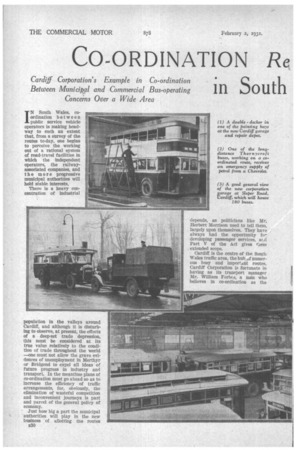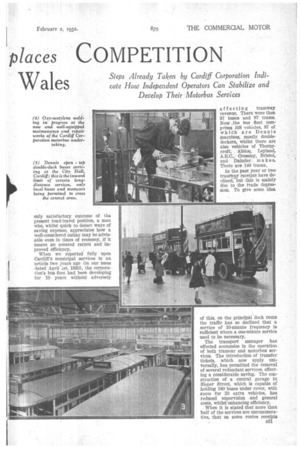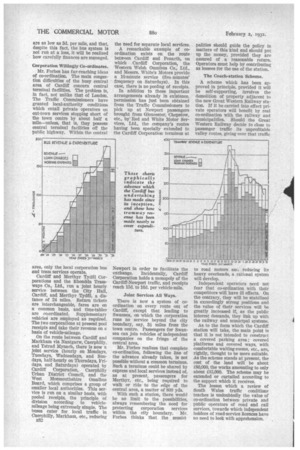CO-ORDINATION Re places COMPETITION
Page 80

Page 81

Page 82

If you've noticed an error in this article please click here to report it so we can fix it.
in South Wales
Cardiff Corporation's Example in Co-ordination Between Municipal and Commercial Bus-operating Concerns Over a Wide Area Steps Already Taken by Cardiff Corporation Indicate How Independent Operators Can Stabilize and Develop Their Motorbus Services
IN South Wales, coordination between public service vehicle operators is making headway to such an extent that, from a survey of the routes to-day, one begins to perceive the working out of a rational system of road-travel facilities in which the independent operators, the railwayassociated companies, and the more progressive municipal authorities will hold stable interests.
There is a heavy concentration of industrial population in the valleys around Cardiff, and although it is disturbing to observe, at present, the effects of a deep-set trade depression, this must be considered at its true value relatively to the condition of trade throughout the world —one must not allow the grave evidences of unemployment in Merthyr or Bridgend to expel all ideas of future progress in industry and transport. In the meantime plans of co-ordination must go ahead so as to increase the efficiency of traffic arrangements, for, obviously, the elimination of wasteful competition and inconvenient journeys is part and parcel of the general policy of economy.
• Just how big a part the municipal authorities will play in the new business of allotting the routes E30
depends, as politicians like Mr. Herbert Morrison used to tell them, largely upon themselves. They have always had the opportunity fo,. developing passenger services, ar.d Part V of the Act gives them . extended scope.
Cardiff is the centre of the South Wales traffic area, the hub uf numerous busy and important routes. Cardiff Corporation is fortunate in having as its transport manager Mr. William Forbes, a man who believes in co-ordination as the only satisfactory outcome of the present road-travel position, a man who, whilst quick to detect ways of saving expense, appreciates how a well-considered outlay may be advisable even in times of economy, if it means an assured return and improved efficiency.
When we reported fully upon Cardiff's municipal services in an article two ;ears ago (in our issue dated April is( 1930), the corporation's bus fleet had been developing for 10 years without adversely
affecting tramway revenue. There were then 97 buses and 97 trams. Now ,the bus fleet comprises BA vehicles, 87 of which are Dennis macaines, mostly doubledeckers, whilst there are also vehicles of Thornycroft, Albion, Leyland, A.E.C., Crossley, Bristol, and Daimler in a k e s. There are 140 trams.,
In the past year or two tramway receipts have declined, but this is mainly due to the trade depression. To give some idea of this, on the principal dock route the traffic has so declined that a service of 10-minute frequency is sufficient where a one-minute service used to be necessary.
The transport manager has effected economies in the operation of both tramcar and motorbus services. The introduction of transfer tickets, which now apply universally, has permitted the removal of several redundant services, effecting a considerable saving. The construction of a central garage in Sloper Street, which is capable of holding 180 buses under cover, with room for 20 extra vehicles, has reduced supervision and general costs, whilst enhancing efficiency.
When it is stated that more than half of the services are unremunerative, that on some routes receipts are as low as 3d. per mile, and that, despite this fact, the bus system is not run at a loss, it will be realized how carefully finances are managed.
Corporation Willingly Co-ordinates.
Mr. Forbes has far-reaching ideas of co-ordination. The main congestion difficulties of the busy central area of Cardiff concern central terminal facilities. The problem is, in fact, not unlike that of London. The Traffic Commissioners have granted local-authority conditions which entail private operators on out-town services stopping short of the town centre by about half a mile—unless, that is, they possess central terminal facilities off the public highway. Within the central
area, only the local corporation bus and tram services operate.
Cardiff and Merthyr Tydfil Corporations and the Rhondda Tramways Co., Ltd., run a joint hourly service between the City Hall, Cardiff, and Merthyr Tydfil, a distance of 24 miles. Return tickets are interchangeable, fares are on a common basis, and time-tables are co-ordinated. Supplementary vehicles are employed as required. The two corporations at present pool receipts and take their revenue on a basis of vehicle-mileage.
On the route between Cardiff and Markham via Nantgarw, Caerphilly, and Ystrad Mynach, there is now a joint service (hourly on Mondays, Tuesdays, Wednesdays, and Sundays, half-hourly on Thursdays, Fri(lays, and Saturdays) operated by Cardiff Corporation, Caerphilly Urban District Council, and the West Monmouthshire Omnibus Board, which comprises a group of smaller local authorities. This service is run on a similar basis, with pooled receipts, the principle of division according to vehiclemileage being extremely simple. The buses cater for local traffic in Caerphilly, Markham, etc., reducing n32 the need for separate local services.
A remarkable example of coordination exists on the route between Cardiff and Penarth, on which Cardiff Corporation, the Western Welsh Omnibus Co., Ltd., and Messrs. White's Motors provide a 10-minute service (five minutes' frequency on Saturdays). In this case, there is no pooling of receipts.
In addition to these important arrangements already in existence, permission has just been obtained from the Traffic Commissioners to pick up at Newport passengers brought from Gloucester, Chepstow, etc., by Red and White Motor Services, Ltd., the company's routes having been specially extended to the Cardiff Corporation terminus at Newport in order to facilitate the exchange. Incidentally, Cardiff Corporation holds a monopoly of the Cardiff-Newport traffic, and receipts reach 15d. to 16d. per vehicle-mile.
Joint Services All Ways.
There is now a system of coordination on every route out of Cardiff, except that leading to Swansea, on which the corporation runs no service beyond the city boundary, say, 31 miles from the town centre. Passengers for Swansea can join vehicles of independent companies on the fringe of the central area.
Mr. Forbes realizes that complete co-ordination, following the line of the advance already taken, is not possible without a common terminus. Such a terminus could be shared by express and local services instead of, as at present, passengers for Merthyr, etc., being required to walk or ride to the edge of the central area, a matter of 800 yds.
With such a station, there would be no limit to the possibilities, always remembering the need for protecting corporation services within the city boundary. Mr. Forbes thinks that the munici palities should guide the policy in matters of this kind and should put up the money, provided they are assured of a reasonable return. Operators must help by contributing as lessees for the use of the station.
The Coach-station Scheme.
A scheme which has been approved in principle, provided it will be self-supporting, involves the demolition of property adjacent to the new Great Western Railway station. If it be carried into effect private operators will benefit by real co-ordination with the railway and municipalities. Should the Great Western Railway decide to close to passenger traffic its unprofitable valley routes, giving over that traffic
to road motors ant", reducing its heavy overheads, a rational system will develop.
Independent operators need not fear that co-ordination with their competitors will have ill effects. On the contrary, they will he stabilized in exceedingly strong positions and the value of their services will be greatly increased if, as the public interest demands, they link up with the railway and municipal systems.
As to the form which the Cardiff station wilt take, the main point is that it is not intended to construct a covered parking area ; covered platforms and covered ways, with comfortable waiting-rooms, etc., are, rightly, thought to be more suitable. As the scheme stands at present, the cost of the land will be about £80,000, the works amounting to only about £15,000. The scheme may be extended or curtailed according to the support which it receives.
The lesson which a review of South Wales traffic conditions teaches is undoubtedly the value of co-ordination between private and public operators of road and rail services, towards which independent holders of road-service licences have no need to look with apprehension.




































































































































































